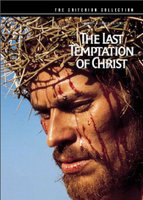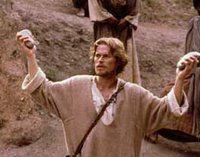Last Temptation of Christ (1988)
 Martin Scorsese's adaptation Nikos Kazantzakis's novel caused so much controversy on it's initial release that the film itself was left largely undiscussed. Thankfully as the dust has settled the film itself has been discussed more insightfully in recent years.
Martin Scorsese's adaptation Nikos Kazantzakis's novel caused so much controversy on it's initial release that the film itself was left largely undiscussed. Thankfully as the dust has settled the film itself has been discussed more insightfully in recent years.The film opens just before Jesus is about to begin his ministry - only he doesn't know it yet. The opening scene begins with a God shot over a tormented Jesus (played by Willem Dafoe) struggling to accept the call of God on his life. In an attempt to flee that call he builds crosses so the Romans can crucify his countrymen. In an attempt to follow it he tries to make amends with Magdalene - he blames himself for her slide into prostitution after he broke off their engagement.
Eventually compelled by the voice he hears he attempts to purify himself in the desert. He is found there by Judas, a zealot, and returns to normal society only to prevent Magdalene getting stoned, and turning the incident into an opportunity to preach Luke's Sermon on the Plain. It is the film's strongest sequence.
 In most Jesus films, his mere presence is enough to pacify the supposedly angry mob. Here Jesus steps into real conflict and danger, his victory unassured. The frightened Jesus has, for a moment, become a brave, risk taker. His actions give him an instant following, and as Jesus escorts Magdalene away he worries whether he can say the right things to his disciples before delivering the beatitudes.
In most Jesus films, his mere presence is enough to pacify the supposedly angry mob. Here Jesus steps into real conflict and danger, his victory unassured. The frightened Jesus has, for a moment, become a brave, risk taker. His actions give him an instant following, and as Jesus escorts Magdalene away he worries whether he can say the right things to his disciples before delivering the beatitudes.Such is the way with Scorsese's Christ. Uncertain, but undeniably anointed and special. Inconsistent, both with himself and the Christ of scripture, yet determined to find the right path, even though he senses it leads to his horrific death.
There are a number of other strong aspects to the film, which is routed far more in an earthy realism than most Christ films. When he raises Lazarus, the crowd recoils from the smell. As Lazarus pulls Jesus towards him, Jesus looks terrified of the power within him pulling him towards his destiny. When we see the wedding at Cana, Scorsese doesn't flinch from showing us a sacrifice there - a far cry from our own "white weddings". The miracle is delivered with a cool nonchalance followed by a wicked grin as his confounded disciples stare at him dumbstruck. This was also the first time on film that Jesus danced. Finally Jesus's trial before Pilate (played by Daivd Bowie) is an unspectacular affair. Pilate dismisses him to his fate with mild disdain. Jesus to him is just another attempted Messiah, and Pilate treats him like all the rest. In another moment of harsh reality, Jesus is crucified naked, stripped of all his dignity.
 But the film has its weaknesses too. Firstly some segments of it are just tiresome, almost as if having faced down so much criticism for even attempting to make the film, he was impervious to any criticism of his artistic choices. In other places the film is just bizarre. John the Baptist is surrounded by a host of naked ecstatics who wail so loudly that Scorsese has to turn the background sound off so we can hear what John is saying. Shortly afterwards Jesus rips out his own heart. During the Eucharist the wine turns so literally into Jesus's blood that one of the disciples removes a clot from his mouth. Some of these maybe the fault of the book, but some are certainly original to the movie.
But the film has its weaknesses too. Firstly some segments of it are just tiresome, almost as if having faced down so much criticism for even attempting to make the film, he was impervious to any criticism of his artistic choices. In other places the film is just bizarre. John the Baptist is surrounded by a host of naked ecstatics who wail so loudly that Scorsese has to turn the background sound off so we can hear what John is saying. Shortly afterwards Jesus rips out his own heart. During the Eucharist the wine turns so literally into Jesus's blood that one of the disciples removes a clot from his mouth. Some of these maybe the fault of the book, but some are certainly original to the movie.The most famous sequence in the film is the last temptation after which the film is named. As he hangs from the cross the background noise again disappears as Jesus appears to mentally moving out from reality. A young girl takes him from the cross and delivers him to a waiting Magdalene in time for their wedding (and she is in a white dress). They marry, have sex, but Magdalene dies. Ultimately Jesus marries Mary of Bethany, and sleeps with her sister before he and his children one day met the apostle Paul, who is preaching Christ crucified and resurrected eventhough, in this sequence it never happens. An aged Jesus is then found on his death bed by Judas and the others, whereupon he realises this is a temptation, and one which he must reject. Instantly he returns to the reality of the cross, and dies with a smile on his face declaring that "it is accomplished".
 Like the rest of the film, the sequence is mixed. Criticisms of the film focused so strongly on this scene, that they seemed to imply that the primary temptation was adultery, not merely the temptation to settle and have a normal life. But the power of that scene is swiftly undermined when Jesus sleep with both Mary and Martha. Equally strange is the scene with Paul who seems content to preach Jesus's victory over death regardless of its truthfulness. Is the film saying Paul and/or the resurrection was a fraud (and most seem to understand it)? Whilst this cannot be ruled out, the logic of this extended sequence is that ultimately Jesus sees that it is false. Perhaps the relationships with Mary and Martha, and the conversation with this Paul figure are where the inconsistencies of this temptation to choose his own way over God's breakdown andthus are highlighted.
Like the rest of the film, the sequence is mixed. Criticisms of the film focused so strongly on this scene, that they seemed to imply that the primary temptation was adultery, not merely the temptation to settle and have a normal life. But the power of that scene is swiftly undermined when Jesus sleep with both Mary and Martha. Equally strange is the scene with Paul who seems content to preach Jesus's victory over death regardless of its truthfulness. Is the film saying Paul and/or the resurrection was a fraud (and most seem to understand it)? Whilst this cannot be ruled out, the logic of this extended sequence is that ultimately Jesus sees that it is false. Perhaps the relationships with Mary and Martha, and the conversation with this Paul figure are where the inconsistencies of this temptation to choose his own way over God's breakdown andthus are highlighted.The ending of the film was also criticied for failing to show a resurrection. Such a charge shows a terrible failure to read the film correctly. The subject matter was how Jesus faced this last temptation. The resurrection is as irrelevant to it's subject matter as the nativity. Yet nevertheless the flash of colours and the optimistic sounding bells that chime as Jesus dies and the credits start to roll, certainly give some hint that this is not the end. But what is most powerful about this scene is the way that it is the only Jesus film which captures one of the fundamental themes of Christianity - the victory of the cross. All other Jesus films capture this as a sad moment. Of course the ending of the story is so well known that the sorrow is never overwhelming, Nevertheless most films, rightly, portray this scene negatively, even if that is underlined with a sense of thankfulness. So it is important to have at least one picture in the Jesus film canon that actually captures the victory of this moment, and the hope that it brings.
Last Temptation of Christ then, is an important, if flawed work. Whilst its flaws, which are both theological and artistic, weaken the film as a whole, they do not damage irredeemably the strong sequences in the film which shed fresh light, and bring new challenges to an old, old story.
Matt
Labels: Last Temptation of Christ














11 Comments:
At 10:50 pm, October 30, 2007, Anonymous said…
Anonymous said…
best movie ever!
At 4:52 pm, November 11, 2007, Anonymous said…
Anonymous said…
i love this movie!
At 10:00 am, November 12, 2007, Matt Page said…
Matt Page said…
Thanks Jake, although I'm a little surprised that anyone likes it quite that much. A lot of people think highly of it, and it's not hard to see why, but usually they quote a minor gripe or two along the way. So it's interesting to hear from you.
Hope you found my comments useful.
Matt
At 6:03 pm, November 22, 2007, Anonymous said…
Anonymous said…
thanks matt!
At 6:09 pm, November 22, 2007, Anonymous said…
Anonymous said…
hey matt'
did you know that another guy named matt
likes this movie too? that's just like your name!
but his his name is matthew dessem. check out his web page at:
http://criterioncollection.blogspot.com/2007/05/70-last-temptation-of-christ.html
At 11:58 am, November 23, 2007, Anonymous said…
Anonymous said…
did you hear me matt?
look on matthew dessem's web page i just posted!
At 12:02 pm, November 23, 2007, Matt Page said…
Matt Page said…
Hi Jake,
I did have a quick look at Dessem's web page, but not had a chance to look at it properly, or to thank you for drawing my attention to it. It's great isn't it?
So, yeah. Thanks for posting the link. Much appreciated.
Matt
At 12:37 pm, November 23, 2007, Anonymous said…
Anonymous said…
thanks' matt!
sorry you didn't a chnce for that.
At 4:54 am, August 14, 2010, franky said…
franky said…
I really disliked the way he portrayed jesus in this movie, so unbiblical.
At 11:13 am, August 18, 2010, Matt Page said…
Matt Page said…
Yes, although that is something the film admits itself in the opening title.
Matt
At 8:02 pm, September 12, 2013, Anonymous said…
Anonymous said…
This movie is not Christian
Post a Comment
<< Home